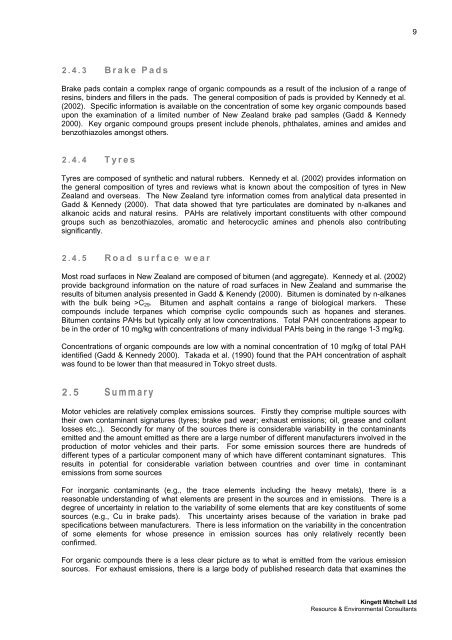The Effects of Road Transport on Freshwater and Marine Ecosystems
The Effects of Road Transport on Freshwater and Marine Ecosystems
The Effects of Road Transport on Freshwater and Marine Ecosystems
Create successful ePaper yourself
Turn your PDF publications into a flip-book with our unique Google optimized e-Paper software.
9<br />
2.4.3 Brake Pads<br />
Brake pads c<strong>on</strong>tain a complex range <str<strong>on</strong>g>of</str<strong>on</strong>g> organic compounds as a result <str<strong>on</strong>g>of</str<strong>on</strong>g> the inclusi<strong>on</strong> <str<strong>on</strong>g>of</str<strong>on</strong>g> a range <str<strong>on</strong>g>of</str<strong>on</strong>g><br />
resins, binders <strong>and</strong> fillers in the pads. <str<strong>on</strong>g>The</str<strong>on</strong>g> general compositi<strong>on</strong> <str<strong>on</strong>g>of</str<strong>on</strong>g> pads is provided by Kennedy et al.<br />
(2002). Specific informati<strong>on</strong> is available <strong>on</strong> the c<strong>on</strong>centrati<strong>on</strong> <str<strong>on</strong>g>of</str<strong>on</strong>g> some key organic compounds based<br />
up<strong>on</strong> the examinati<strong>on</strong> <str<strong>on</strong>g>of</str<strong>on</strong>g> a limited number <str<strong>on</strong>g>of</str<strong>on</strong>g> New Zeal<strong>and</strong> brake pad samples (Gadd & Kennedy<br />
2000). Key organic compound groups present include phenols, phthalates, amines <strong>and</strong> amides <strong>and</strong><br />
benzothiazoles am<strong>on</strong>gst others.<br />
2.4.4 Tyres<br />
Tyres are composed <str<strong>on</strong>g>of</str<strong>on</strong>g> synthetic <strong>and</strong> natural rubbers. Kennedy et al. (2002) provides informati<strong>on</strong> <strong>on</strong><br />
the general compositi<strong>on</strong> <str<strong>on</strong>g>of</str<strong>on</strong>g> tyres <strong>and</strong> reviews what is known about the compositi<strong>on</strong> <str<strong>on</strong>g>of</str<strong>on</strong>g> tyres in New<br />
Zeal<strong>and</strong> <strong>and</strong> overseas. <str<strong>on</strong>g>The</str<strong>on</strong>g> New Zeal<strong>and</strong> tyre informati<strong>on</strong> comes from analytical data presented in<br />
Gadd & Kennedy (2000). That data showed that tyre particulates are dominated by n-alkanes <strong>and</strong><br />
alkanoic acids <strong>and</strong> natural resins. PAHs are relatively important c<strong>on</strong>stituents with other compound<br />
groups such as benzothiazoles, aromatic <strong>and</strong> heterocyclic amines <strong>and</strong> phenols also c<strong>on</strong>tributing<br />
significantly.<br />
2.4.5 <str<strong>on</strong>g>Road</str<strong>on</strong>g> surface wear<br />
Most road surfaces in New Zeal<strong>and</strong> are composed <str<strong>on</strong>g>of</str<strong>on</strong>g> bitumen (<strong>and</strong> aggregate). Kennedy et al. (2002)<br />
provide background informati<strong>on</strong> <strong>on</strong> the nature <str<strong>on</strong>g>of</str<strong>on</strong>g> road surfaces in New Zeal<strong>and</strong> <strong>and</strong> summarise the<br />
results <str<strong>on</strong>g>of</str<strong>on</strong>g> bitumen analysis presented in Gadd & Kenendy (2000). Bitumen is dominated by n-alkanes<br />
with the bulk being >C 29 . Bitumen <strong>and</strong> asphalt c<strong>on</strong>tains a range <str<strong>on</strong>g>of</str<strong>on</strong>g> biological markers. <str<strong>on</strong>g>The</str<strong>on</strong>g>se<br />
compounds include terpanes which comprise cyclic compounds such as hopanes <strong>and</strong> steranes.<br />
Bitumen c<strong>on</strong>tains PAHs but typically <strong>on</strong>ly at low c<strong>on</strong>centrati<strong>on</strong>s. Total PAH c<strong>on</strong>centrati<strong>on</strong>s appear to<br />
be in the order <str<strong>on</strong>g>of</str<strong>on</strong>g> 10 mg/kg with c<strong>on</strong>centrati<strong>on</strong>s <str<strong>on</strong>g>of</str<strong>on</strong>g> many individual PAHs being in the range 1-3 mg/kg.<br />
C<strong>on</strong>centrati<strong>on</strong>s <str<strong>on</strong>g>of</str<strong>on</strong>g> organic compounds are low with a nominal c<strong>on</strong>centrati<strong>on</strong> <str<strong>on</strong>g>of</str<strong>on</strong>g> 10 mg/kg <str<strong>on</strong>g>of</str<strong>on</strong>g> total PAH<br />
identified (Gadd & Kennedy 2000). Takada et al. (1990) found that the PAH c<strong>on</strong>centrati<strong>on</strong> <str<strong>on</strong>g>of</str<strong>on</strong>g> asphalt<br />
was found to be lower than that measured in Tokyo street dusts.<br />
2.5 Summary<br />
Motor vehicles are relatively complex emissi<strong>on</strong>s sources. Firstly they comprise multiple sources with<br />
their own c<strong>on</strong>taminant signatures (tyres; brake pad wear; exhaust emissi<strong>on</strong>s; oil, grease <strong>and</strong> collant<br />
losses etc.,). Sec<strong>on</strong>dly for many <str<strong>on</strong>g>of</str<strong>on</strong>g> the sources there is c<strong>on</strong>siderable variability in the c<strong>on</strong>taminants<br />
emitted <strong>and</strong> the amount emitted as there are a large number <str<strong>on</strong>g>of</str<strong>on</strong>g> different manufacturers involved in the<br />
producti<strong>on</strong> <str<strong>on</strong>g>of</str<strong>on</strong>g> motor vehicles <strong>and</strong> their parts. For some emissi<strong>on</strong> sources there are hundreds <str<strong>on</strong>g>of</str<strong>on</strong>g><br />
different types <str<strong>on</strong>g>of</str<strong>on</strong>g> a particular comp<strong>on</strong>ent many <str<strong>on</strong>g>of</str<strong>on</strong>g> which have different c<strong>on</strong>taminant signatures. This<br />
results in potential for c<strong>on</strong>siderable variati<strong>on</strong> between countries <strong>and</strong> over time in c<strong>on</strong>taminant<br />
emissi<strong>on</strong>s from some sources<br />
For inorganic c<strong>on</strong>taminants (e.g., the trace elements including the heavy metals), there is a<br />
reas<strong>on</strong>able underst<strong>and</strong>ing <str<strong>on</strong>g>of</str<strong>on</strong>g> what elements are present in the sources <strong>and</strong> in emissi<strong>on</strong>s. <str<strong>on</strong>g>The</str<strong>on</strong>g>re is a<br />
degree <str<strong>on</strong>g>of</str<strong>on</strong>g> uncertainty in relati<strong>on</strong> to the variability <str<strong>on</strong>g>of</str<strong>on</strong>g> some elements that are key c<strong>on</strong>stituents <str<strong>on</strong>g>of</str<strong>on</strong>g> some<br />
sources (e.g., Cu in brake pads). This uncertainty arises because <str<strong>on</strong>g>of</str<strong>on</strong>g> the variati<strong>on</strong> in brake pad<br />
specificati<strong>on</strong>s between manufacturers. <str<strong>on</strong>g>The</str<strong>on</strong>g>re is less informati<strong>on</strong> <strong>on</strong> the variability in the c<strong>on</strong>centrati<strong>on</strong><br />
<str<strong>on</strong>g>of</str<strong>on</strong>g> some elements for whose presence in emissi<strong>on</strong> sources has <strong>on</strong>ly relatively recently been<br />
c<strong>on</strong>firmed.<br />
For organic compounds there is a less clear picture as to what is emitted from the various emissi<strong>on</strong><br />
sources. For exhaust emissi<strong>on</strong>s, there is a large body <str<strong>on</strong>g>of</str<strong>on</strong>g> published research data that examines the<br />
Kingett Mitchell Ltd<br />
Resource & Envir<strong>on</strong>mental C<strong>on</strong>sultants
















